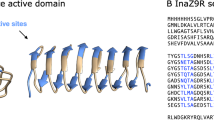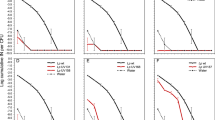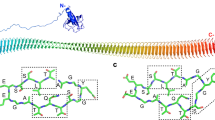Abstract
A growing body of circumstantial evidence suggests that ice nucleation active (Ice+) bacteria contribute to the initiation of precipitation by heterologous freezing of super-cooled water in clouds. However, little is known about the concentration of Ice+ bacteria in precipitation, their genetic and phenotypic diversity, and their relationship to air mass trajectories and precipitation chemistry. In this study, 23 precipitation events were collected over 15 months in Virginia, USA. Air mass trajectories and water chemistry were determined and 33 134 isolates were screened for ice nucleation activity (INA) at −8 °C. Of 1144 isolates that tested positive during initial screening, 593 had confirmed INA at −8 °C in repeated tests. Concentrations of Ice+ strains in precipitation were found to range from 0 to 13 219 colony forming units per liter, with a mean of 384±147. Most Ice+ bacteria were identified as members of known and unknown Ice+ species in the Pseudomonadaceae, Enterobacteriaceae and Xanthomonadaceae families, which nucleate ice employing the well-characterized membrane-bound INA protein. Two Ice+ strains, however, were identified as Lysinibacillus, a Gram-positive genus not previously known to include Ice+ bacteria. INA of the Lysinibacillus strains is due to a nanometer-sized molecule that is heat resistant, lysozyme and proteinase resistant, and secreted. Ice+ bacteria and the INA mechanisms they employ are thus more diverse than expected. We discuss to what extent the concentration of culturable Ice+ bacteria in precipitation and the identification of a new heat-resistant biological INA mechanism support a role for Ice+ bacteria in the initiation of precipitation.
Similar content being viewed by others
Log in or create a free account to read this content
Gain free access to this article, as well as selected content from this journal and more on nature.com
or
References
Ahmed I, Yokota A, Yamazoe A, Fujiwara T . (2007). Proposal of Lysinibacillus boronitolerans gen. nov. sp. nov., and transfer of Bacillus fusiformis to Lysinibacillus fusiformis comb. nov. and Bacillus sphaericus to Lysinibacillus sphaericus comb. nov. Int J Syst Evol Micr 57: 1117–1125.
Amato P, Joly M, Schaupp C, Attard E, Möhler O, Morris CE et al. (2015). Survival and ice nucleation activity of bacteria as aerosols in a cloud simulation chamber. Atmos Chem Phys Discuss 15: 6455–6465.
Arny DC, Lindow SE, Upper CD . (1976). Frost sensitivity of Zea mays increased by application of Pseudomonas syringae. Nature 262: 282–284.
Attard E, Yang H, Delort AM, Amato P, Poeschl U, Glaux C et al. (2012). Effects of atmospheric conditions on ice nucleation activity of Pseudomonas. Atmos Chem Phys 12: 10667–10677.
Barer MR, Harwood CR . (1999). Bacterial viability and culturability. Adv Microb Physiol 41: 93–137.
Berge O, Monteil CL, Bartoli C, Chandeysson C, Guilbaud C, Sands DC et al. (2014). A user's guide to a data base of the diversity of Pseudomonas syringae and its application to classifying strains in this phylogenetic complex. Plos One 9: e105547.
Bigg EK, Soubeyrand S, Morris CE . (2015). Persistent after-effects of heavy rain on concentrations of ice nuclei and rainfall suggest a biological cause. Atmos Chem Phys 15: 2313–2326.
Christner BC, Morris CE, Foreman CM, Cai RM, Sands DC . (2008). Ubiquity of biological ice nucleators in snowfall. Science 319: 1214–1214.
Cole JR, Wang Q, Fish JA, Chai B, McGarell DM, Sun Y et al. (2014). Ribosomal Database Project: data and tools for high throughput rRNA analysis. Nucleic Acids Res 1: D633–D642.
Constantinidou HA, Hirano SS, Baker LS, Upper CD . (1990). Atmospheric dispersal of ice nucleation active bacteria—the role of rain. Phytopathology 80: 934–937.
Crawford I, Bower KN, Choularton TW, Dearden C, Crosier J, Westbrook C et al. (2012). Ice formation and development in aged, wintertime cumulus over the UK: observations and modelling. Atmos Chem Phys 12: 4963–4985.
Diehl K, Matthias-Maser S, Jaenicke R, Mitra SK . (2002). The ice nucleating ability of pollen: Part II. Laboratory studies in immersion and contact freezing modes. Atmos Res 61: 125–133.
Du R, Du P, Lu Z, Ren W, Liang Z, Qin S et al. (2017). Evidence for a missing source of efficient ice nuclei. Sci Rep 7: 39673.
Emersic C, Connolly PJ, Boult S, Campana M, Li Z . (2015). Investigating the discrepancy between wet-suspension- and dry-dispersion-derived ice nucleation efficiency of mineral particles. Atmos Chem Phys 15: 11311–11326.
Fröhlich-Nowoisky J, Hill TCJ, Pummer BG, Yordanova P, Franc GD, Pöschl U . (2015). Ice nucleation activity in the widespread soil fungus Mortierella alpina. Biogeosciences 12: 1057–1071.
Garcia E, Hill TC, Prenni AJ, DeMott PJ, Franc GD, Kreidenweis SM . (2012). Biogenic ice nuclei in boundary layer air over two US high plains agricultural regions. J Geophys Res 117.
Garnham CP, Campbell RL, Walker VK, Davies PL . (2011). Novel dimeric beta-helical model of an ice nucleation protein with bridged active sites. Bmc Structural Biol 11.
Garrido-Sanz D, Meier-Kolthoff J, Göker M, Martín M, Rivilla R, Redondo-Nieto M . (2016). Genomic and genetic diversity within the Pseudomonas fluorescens Complex. PLoS ONE 11: e0150183.
Hill TC, Moffett B, DeMott PJ, Georgakopoulos DG, Stump WL, Franc GD . (2014). Measurement of ice nucleation-active bacteria on plants and in precipitation by quantitative PCR. Appl Env Microbiol 80: 1256–1267.
Hirano SS, Baker LS, Upper CD . (1985). Ice nucleation temperature of individual leaves in relation to population sizes of ice nucleation active bacteria and frost injury. Plant Physiol 77: 259–265.
Hoose C, Mohler O . (2012). Heterogeneous ice nucleation on atmospheric aerosols: a review of results from laboratory experiments. Atmos Chem Phys 12: 9817–9854.
Joly M, Attard E, Sancelme M, Deguillaume L, Guilbaud C, Morris CE et al. (2013). Ice nucleation activity of bacteria isolated from cloud water. Atmos Environ 70: 392–400.
Kaeberlein T, Lewis K, Epstein SS . (2002). Isolating ‘uncultivable’ microorganims in pure culture in a simulated natural environment. Science 296: 1127–1129.
Kajava A, Lindow S . (1993). A model of the three-dimensional structure of ice nucleation proteins. J Mol Biol 232: 709–717.
Kim HK, Orser C, Lindow SE, Sands DC . (1987). Xanthomonas campestris pv. translucens strains active in ice nucleation. Plant Dis 71: 994–997.
Lee MR, Lee RE, Strong-Gunderson JM, Minges SR . (1995). Isolation of ice-nucleating active bacteria from the freeze-tolerant frog Rana sylvatica. Cryobiology 32: 358–365.
Lindemann J, Constantinidou HA, Barchet WR, Upper CD . (1982). Plants as sources of airborne bacteria, including ice nucleation active bacteria. Appl Env Microbiol 44: 1059–1063.
Lindow S, Arny DC, Upper CD . (1978). Erwinia herbicola: a bacterial ice nucleus active in increasing frost injury to corn. Phytopathology 68: 523–527.
Lindow SE . (1983). The role of bacterial ice nucleation in frost injury to plants. Annu Rev Phytopathol 21: 363–384.
Maki LR, Galyan EL, Chang-Chien MM, Caldwell DR . (1974). Ice nucleation induced by Pseudomonas syringae. Appl Microbiol 28: 456–459.
Miwa H, Ahmed I, Yokota A, Fujiwara T . (2009). Lysinibacillus parviboronicapiens sp. nov., a low-boron-containing bacterium isolated from soil. Int J Syst Evol Micr 59: 1427–1432.
Monteil CL, Guilbaud C, Glaux C, Lafolie F, Soubeyrand S, Morris CE . (2012). Emigration of the plant pathogen Pseudomonas syringae from leaf litter contributes to its population dynamics in alpine snowpack. Environ Microbiol 14: 2099–2112.
Monteil CL, Bardin M, Morris CE . (2014a). Features of air masses associated with the deposition of Pseudomonas syringae and Botrytis cinerea by rain and snowfall. ISME J 8: 2290–2304.
Monteil CL, Lafolie F, Laurent J, Clement JC, Simler R, Travi Y et al. (2014b). Soil water flow is a source of the plant pathogen Pseudomonas syringae in subalpine headwaters. Environ Microbiol 16: 2038–2052.
Morris CE, Glaux C, Latour X, Gardan L, Samson R, Pitrat M . (2000). The relationship of host range, physiology, and genotype to virulence on cantaloupe in Pseudomonas syringae from cantaloupe blight epidemics in France. Phytopathology 90: 636–646.
Morris CE, Georgakopoulos DG, Sands DC . (2004). Ice nucleation active bacteria and their potential role in precipitation. J Phys IV 121: 87–103.
Morris CE, Sands DC, Vinatzer BA, Glaux C, Guilbaud C, Buffiere A et al. (2008). The life history of the plant pathogen Pseudomonas syringae is linked to the water cycle. ISME J 2: 321–334.
Morris CE, Conen F, Huffman JA, Phillips V, Pöschl U, Sands DC . (2014). Bioprecipitation: feedbacks linking Earth history, ecosystem dynamics and land use through biological ice nucleators in the atmosphere. Global Change Biol 20: 341–351.
Mortazavi R, Hayes CT, Ariya PA . (2008). Ice nucleation activity of bacteria isolated from snow compared with organic and inorganic substrates. Environ Chem 5: 373–381.
Mülmenstädt J, Sourdeval O, Delanoë J, Quaas J . (2015). Frequency of occurrence of rain from liquid-, mixed-, and ice-phase clouds derived from A-Train satellite retrievals. Geophys Res Lett 42: 6502–6509.
Murray BJ, O'Sullivan D, Atkinson JD, Webb ME . (2012). Ice nucleation by particles immersed in supercooled cloud droplets. Chem Soc Rev 41: 6519–6554.
Nemecek-Marshall M, Laduca R, Fall R . (1993). High level expression of ice nuclei in a Pseudomonas syringae strain is induced by nutrient limitation and low temperature. J Bacteriol 175: 4062–4070.
O'Sullivan D, Murray BJ, Ross JF, Whale TF, Price HC, Atkinson JD et al. (2015). The relevance of nanoscale biological fragments for ice nucleation in clouds. Sci Rep 5: 8082.
Pandey R, Usui K, Livingstone RA, Fischer SA, Pfaendtner J, Backus EHG et al. (2016). Ice-nucleating bacteria control the order and dynamics of interfacial water. Sci Adv 2: e1501630.
Petters MD, Wright TP . (2015). Revisiting ice nucleation from precipitation samples. Geophys Res Lett 42: 8758–8766.
Phelps P, Giddings TH, Prochoda M, Fall R . (1986). Release of cell-free ice nuclei by Erwinia herbicola. J Bacteriol 167: 496–502.
Ponder MA, Gilmour SJ, Bergholz PW, Mindock CA, Hollingsworth R, Thomashow MF et al. (2005). Characterization of potential stress responses in ancient Siberian permafrost psychroactive bacteria. FEMS Microbiol Ecol 53: 103–115.
Pouleur S, Richard C, Martin JG, Antoun H . (1992). Ice nucleation activity in Fusarium acuminatum and Fusarium avenaceum. Appl Env Microbiol 58: 2960–2964.
Pummer BG, Bauer H, Bernardi J, Bleicher S, Grothe H . (2012). Suspendable macromolecules are responsible for ice nucleation activity of birch and conifer pollen. Atmos Chem Phys 12: 2541–2550.
Pummer BG, Budke C, Augustin-Bauditz S, Niedermeier D, Felgitsch L, Kampf CJ et al. (2015). Ice nucleation by water-soluble macromolecules. Atmos Chem Phys 15: 4077–4091.
R Core Team. (2014) R: A language and environment for statistical computing. R Foundation for Statistical Computing: Vienna, Austria.
Sands DC, Langhans VE, Scharen AL, de Smet G . (1982). The association between bacteria and rain and possible resultant meteorological implications. J Hungarian Meteorol Ser 86: 148–152.
Šantl-Temkiv T, Sahyoun M, Finster K, Hartmann S, Augustin-Bauditz S, Stratmann F et al. (2015). Characterization of airborne ice-nucleation-active bacteria and bacterial fragments. Atmos Environ 109: 105–117.
Sarkar SF, Guttman DS . (2004). Evolution of the core genome of Pseudomonas syringae, a highly clonal, endemic plant pathogen. Appl Env Microbiol 70: 1999–2012.
Stopelli E, Conen F, Morris CE, Herrmann E, Bukowiecki N, Alewell C . (2015). Ice nucleation active particles are efficiently removed by precipitating clouds. Sci Rep 5: 16433.
Vali G . (1966). Sizes of atmospheric ice nuclei. Nature Biotechnol 212: 384–385.
Vali G . (1971). Quantitative evaluation of experimental results on the heterogeneous freezing nucleation of supercooled liquids. J Atmos Sci 28: 402–409.
von Blohn N, Mitra SK, Diehl K, Borrmann S . (2005). The ice nucleating ability of pollen Part III: New laboratory studies in immersion and contact freezing modes including more pollen types. Atmos Res 78: 182–189.
Whale TF, Murray BJ, O'Sullivan D, Wilson TW, Umo NS, Baustian KJ et al. (2015). A technique for quantifying heterogeneous ice nucleation in microlitre supercooled water droplets. Atmos Meas Tech 8: 2437–2447.
Wolber PK, Deininger CA, Southworth MW, Vandekerckhove J, Vanmontagu M, Warren GJ . (1986). Identification and purification of a bacterial ice nucleation protein. Proc Natl Acad Sci USA 83: 7256–7260.
Acknowledgements
The authors gratefully acknowledge the NOAA Air Resources Laboratory (ARL) for the provision of the HYSPLIT transport and dispersion model and/or READY website (http://www.ready.noaa.gov) used in this publication. This research was supported by the National Science Foundation under grant DEB-1241068. Funding to Boris A. Vinatzer and David G. Schmale III was also provided in part by the Virginia Agricultural Experiment Station and the Hatch Program of the National Institute of Food and Agriculture, US Department of Agriculture.
Author information
Authors and Affiliations
Corresponding authors
Ethics declarations
Competing interests
The authors declare no conflict of interest.
Additional information
Supplementary Information accompanies this paper on The ISME Journal website
Supplementary information
Rights and permissions
About this article
Cite this article
Failor, K., Schmale, D., Vinatzer, B. et al. Ice nucleation active bacteria in precipitation are genetically diverse and nucleate ice by employing different mechanisms. ISME J 11, 2740–2753 (2017). https://doi.org/10.1038/ismej.2017.124
Received:
Revised:
Accepted:
Published:
Issue date:
DOI: https://doi.org/10.1038/ismej.2017.124
This article is cited by
-
Viability studies of bacterial strains exposed to nitrogen oxides and light in controlled atmospheric conditions
Scientific Reports (2025)
-
Selection processes of Arctic seasonal glacier snowpack bacterial communities
Microbiome (2023)
-
Ice nucleation catalyzed by the photosynthesis enzyme RuBisCO and other abundant biomolecules
Communications Earth & Environment (2023)
-
Aerial transport of bacteria by dust plumes in the Eastern Mediterranean revealed by complementary rRNA/rRNA-gene sequencing
Communications Earth & Environment (2023)
-
Prevalence and characterization of Ice Nucleation Active (INA) bacteria from rainwater in Indonesia
BMC Microbiology (2022)



